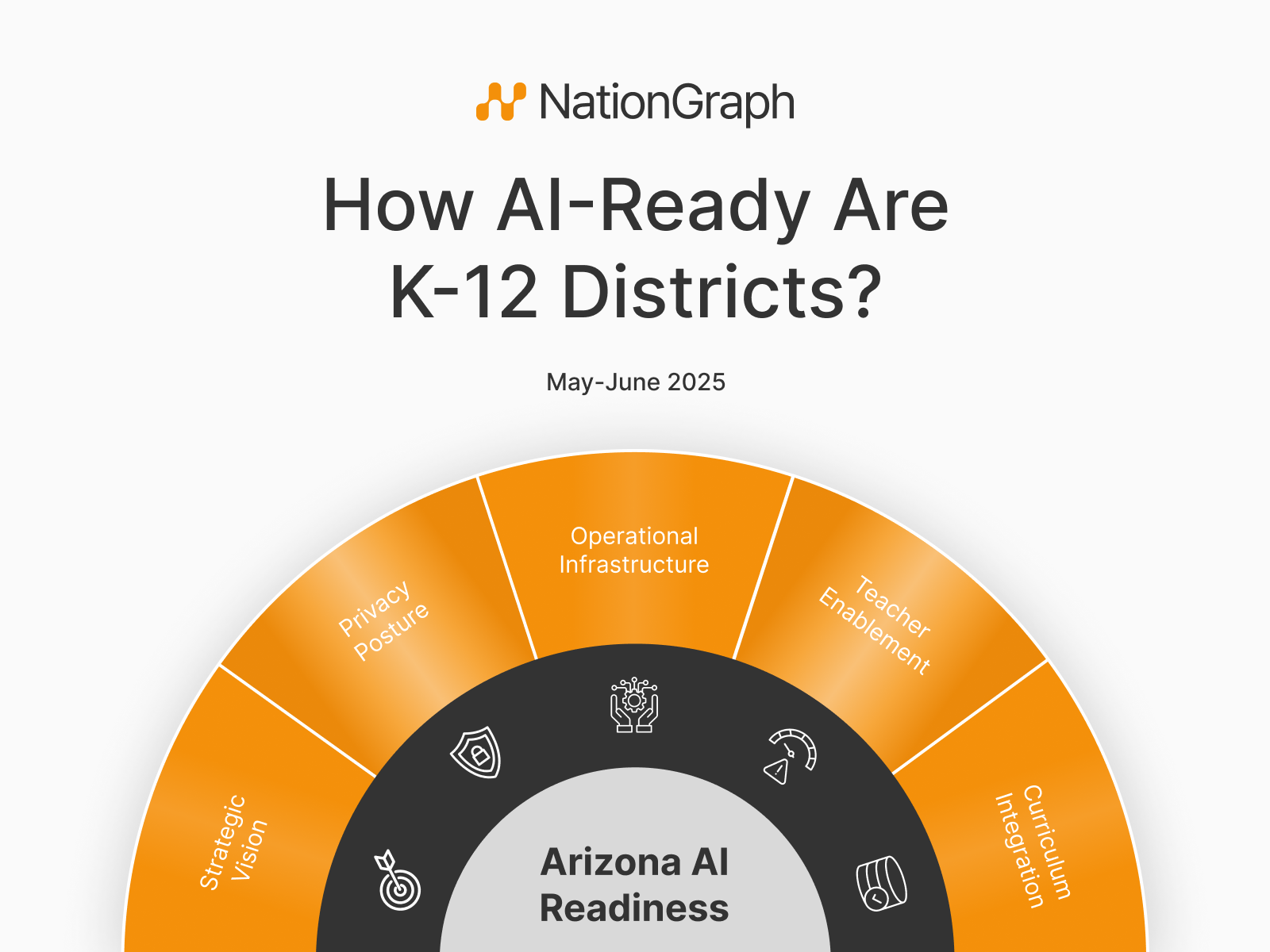K-12 Market Analysis: What 410 Purchase Orders Reveal About Procurement Software
%2520(1).png)
School district procurement data reveals everything: who's buying, when they buy, and how much they spend. We analyzed 410 typing software purchases to show EdTech companies exactly how K-12 markets really work.
How School Districts Actually Buy Typing Software
Our analysis of $1.25 million in typing software purchases across 309 school districts uncovered several critical patterns that EdTech vendors need to understand:
- 77% of purchases were under $5,000, with 41% under $1,000
- Average deal size: $3,396 across all districts
- Customer concentration risk: Top 10 customers drive nearly half of total revenue
- Seasonal buying pattern: 53% of purchases happen in Q3 (summer months)
- Short contract terms: 90% are annual agreements, creating renewal vulnerability
Purchase Order Value Distribution
Q: What do most school districts spend on typing software?
A: Most districts spend very little, 77% of all purchases are under $5,000 with nearly half spending less than $1,000. This suggests that typing software is often treated as a low-priority, budget-conscious purchase rather than a strategic technology investment.
Here's the complete breakdown:
- Under $1,000: 41% of all purchases
- $1,000-$2,000: 23% of purchases
- $2,000-$5,000: 13% of purchases
- $5,000-$10,000: 13% of purchases
- Over $10,000: Only 10% of purchases
Customer Concentration Analysis
The market shows extreme customer concentration, with the top 20 districts accounting for a disproportionate share of revenue:
%2520(3).png)
Key insight for competitors: Winning just a few large district contracts could significantly impact market share, but the majority of the market consists of small, price-sensitive buyers.
Seasonal Buying Patterns: When Districts Purchase
Q: When do school districts buy typing software?
A: Summer dominates, with 53% of all purchases happening in Q3 (June-August). This aligns with typical school budget cycles and pre-academic year preparation.
Monthly breakdown:
- June: 18% of annual purchases
- July: 20% of annual purchases
- August: 15% of annual purchases
- September: 12% of annual purchases
Strategic implication: Competitors should focus prospecting efforts in Q1-Q2, before the peak buying season, and offer "early-bird" incentives for districts that plan ahead.
Pricing Strategy Analysis
Per-Student Pricing Model
Our analysis revealed that 84% of identifiable contracts use per-student licensing, with an average price of $287.72 per student. However, this average masks extreme variation ranging from $0.06 to $1,716 per student.
This pricing inconsistency suggests potential market vulnerability that competitors could exploit with more transparent, standardized pricing.
Contract Term Structure
Q: How long are typical typing software contracts?
A: 90% of contracts are one-year terms, with only 7% extending to multi-year agreements. This creates annual renewal vulnerability and switching opportunities for competitors.
Contract length distribution:
- 1-year contracts: 90%
- 2-year contracts: 5%
- 3-year contracts: 2%
- Other/unclear: 3%
Market Opportunities for Competitors
Pricing Vulnerabilities
- Inconsistent pricing creates confusion and potential overcharging
- Short contract terms mean annual switching opportunities
- Limited multi-year discounts suggest customers aren't incentivized for longer commitments
Product Differentiation Gaps
Our analysis of purchase order descriptions revealed limited feature emphasis:
- "Typing" mentioned: 41% of descriptions
- Assessment features: 0.2% of descriptions
- Grade-specific targeting: Less than 1% of descriptions
- Curriculum integration: Minimal mentions
Opportunity: Competitors can differentiate by emphasizing advanced features like progress tracking, curriculum alignment, and comprehensive reporting.
Geographic and Channel Opportunities
- 100% direct sales model with no evidence of reseller partnerships
- No apparent regional concentration strategy
- Limited bundling with complementary products (only 2.7% of entries)
Competitive Strategy Recommendations
For EdTech Companies Entering This Market:
1. Price Point Strategy
- Offer transparent pricing 10-15% below market average ($2-3 per student)
- Incentivize multi-year contracts with 15-20% discounts
- Eliminate pricing complexity and variation
2. Product Differentiation Focus
- Emphasize LMS integration capabilities
- Add robust assessment and progress tracking
- Develop grade-specific curriculum alignment
- Create comprehensive reporting dashboards
3. Sales Timing Strategy
- Target Q1-Q2 for prospecting (before peak season)
- Create early-bird promotions for advance planners
- Focus renewal discussions in Q4 (before competitor's peak)
4. Channel Strategy
- Develop reseller partnerships with educational consultants
- Bundle with complementary EdTech solutions
- Partner with curriculum publishers
Contract Renewal Intelligence
Q: Which districts have contracts expiring soon?
A: We identified specific contracts expiring in 2025 that represent immediate competitive opportunities:
- Connetquot Central School District: $9,840 contract expiring 8/19/2025
- Burbank Unified: $1,881 contract expiring 8/1/2025
This represents the power of purchase order intelligence—knowing exactly when contracts expire enables perfectly timed competitive outreach.
Market Size and Growth Patterns
Revenue Trends Analysis
Based on our dataset analysis:
- 2022: +75.6% growth year-over-year
- 2023: Moderate growth continuation
- 2024: Negative growth trend
This growth deceleration suggests market maturity and increased competition, creating opportunities for well-positioned new entrants.
How to Use This Intelligence for Your Sales Strategy
For Sales Teams Targeting This Market:
1. Prospect Timing
- Begin outreach in January-March for summer decision cycles
- Target renewal conversations 90 days before contract expiration
- Focus on Q4 for next-year budget discussions
2. Pricing Positioning
- Position against the $3,396 average deal size
- Emphasize value per student vs. total contract cost
- Offer multi-year savings to differentiate from 1-year standard
3. Competitive Differentiation
- Highlight advanced features beyond basic typing
- Emphasize integration capabilities with existing systems
- Focus on ROI through improved student outcomes and teacher efficiency
FAQ: K-12 Typing Software Procurement
Q: What's the typical budget approval process for typing software in K-12?
A: Given that 77% of purchases are under $5,000, most typing software purchases fall below formal RFP thresholds and can be approved through simplified procurement processes or cooperative contracts.
Q: Do districts prefer per-student or site licensing?
A: Our data shows 84% use per-student licensing, likely due to budget predictability and the ability to scale based on actual usage.
Q: When should EdTech companies start their K-12 sales outreach?
A: Begin prospecting in Q1-Q2, as 53% of purchases happen in Q3. This gives time for evaluation, budgeting, and decision-making before the peak buying season.
Q: How often do districts switch typing software providers?
A: With 90% using annual contracts and only 7.8% of records showing explicit renewals, there appears to be significant churn or switching behavior, though our data limitations prevent definitive conclusions.
Q: What's the largest opportunity in this market?
A: The customer concentration (top 10 customers = 50% of revenue) combined with short contract terms suggests that winning a few large district renewals could dramatically impact market share.
Next Steps: Leveraging Procurement Intelligence
This analysis demonstrates the power of procurement data in understanding market dynamics, competitive positioning, and sales opportunities. Instead of guessing about district buying patterns, successful EdTech companies use real purchase order data to inform their strategy.
How NationGraph Powers This Analysis
We analyzed this typing software market using our comprehensive database of public sector purchase orders, which includes:
- Purchase order amounts and terms
- Contract expiration dates
- Pricing models and structures
- Seasonal buying patterns
- Competitive landscape mapping
Want similar intelligence for your market? We can run this same analysis for any EdTech category, specific competitors, or target geographic regions.
Immediate Action Items
For EdTech executives:
- Audit your pricing strategy against the market averages revealed here
- Review your contract terms to identify multi-year incentive opportunities
- Assess your product positioning against the feature gaps we identified
- Plan your 2025 sales calendar around the seasonal patterns
For sales teams:
- Identify target districts with contracts expiring in your category
- Develop renewal early-warning systems for competitive opportunities
- Adjust your pitch to emphasize differentiation beyond basic functionality
- Time your outreach for maximum effectiveness
This analysis was conducted using NationGraph's comprehensive public sector procurement database covering 100,000+ public sector entities. For competitive intelligence on your specific market or to identify immediate sales opportunities, get a demo to see how procurement data can transform your sales strategy.



.png)

.png)